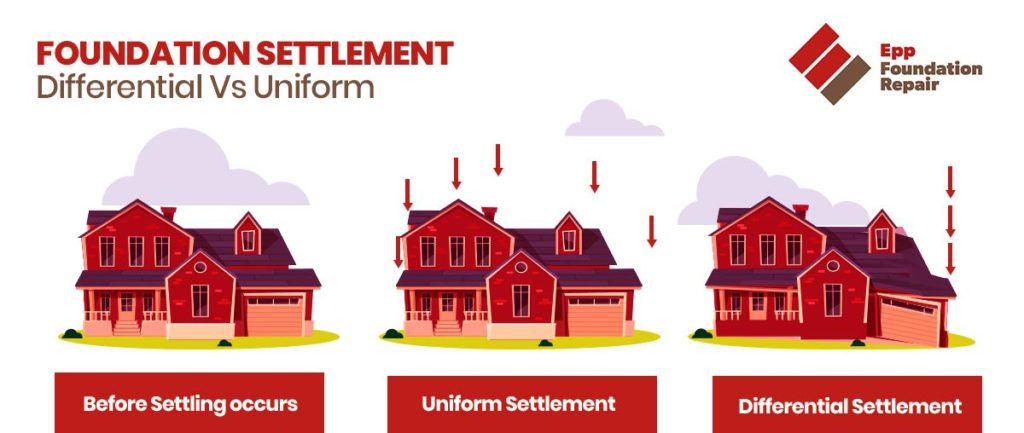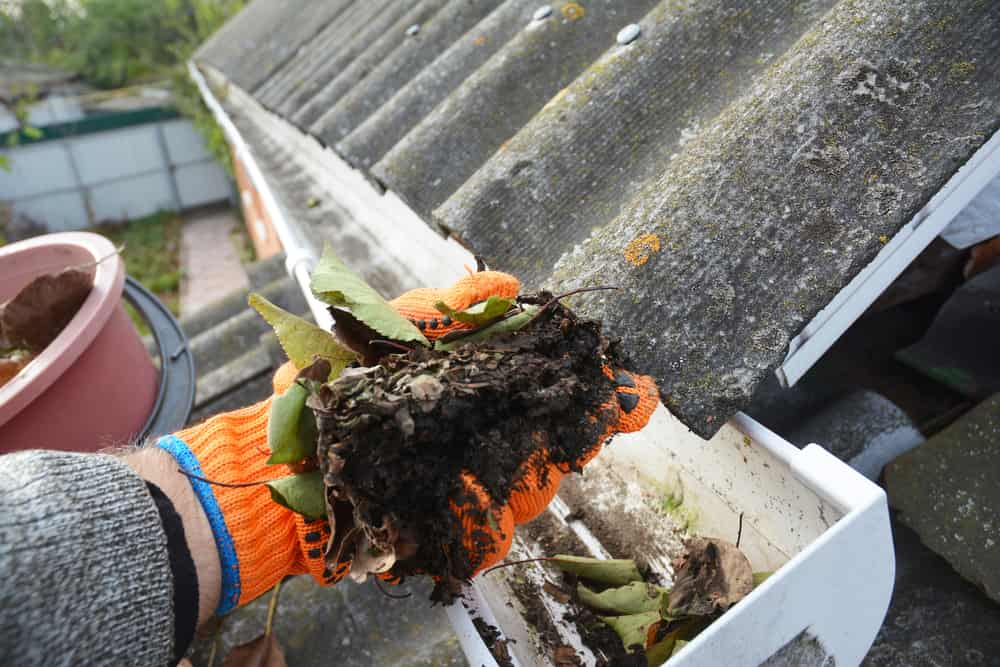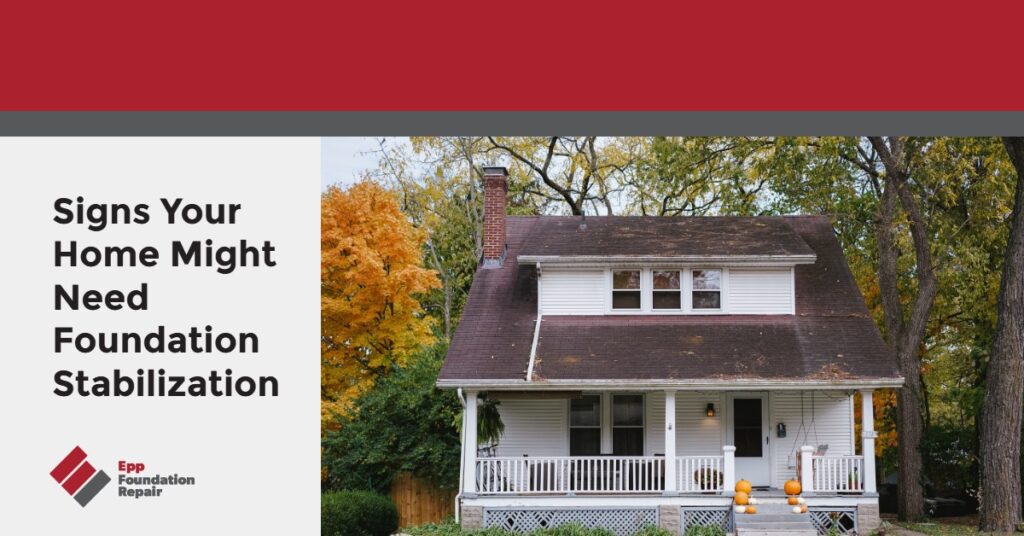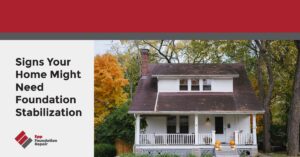Foundation stabilization is exactly as it sounds. It’s about stabilizing your home’s foundation in order to make it stronger. Foundation stabilization is necessary when something has made your home’s foundation weaker. This is usually a phenomenon referred to as “differential settlement.” We’ll explain differential settlement in the Causes of Foundation Problems section below.
This article will go over the causes of foundation problems, signs your home might need foundation stabilization, types of foundation stabilization, and more.
Causes of Foundation Problems
The abovementioned “differential settlement causes most foundation problems.” Differential settlement is when the house is settling into the soil unevenly. (See the below graphic.) Differential settlement puts stress on the foundation leading to structural damage.

What Causes Differential Settlement?
Water is the leading cause of differential settlement. Either too much or not enough water in the soil around the home will lead to differential settlement and foundation trouble requiring foundation stabilization. Here are a few ways water can cause differential settlement:
- Water causes expansive clay soil to swell and shrink – Soil with a large amount of clay is referred to as “expansive.” This is because it swells when it soaks up water and shrinks when it dries out. This is usually seasonal and creates movement in the soil under the foundation. Over time this will lead to differential settlement requiring foundation stabilization to lift and level the house.
- Water washes away erosion-prone soil – Some types of soil are prone to erosion, and that, coupled with water, can create voids under the foundation leading to differential settlement and, eventually, the cost of foundation stabilization.
- Vegetation around the foundation – There are two ways vegetation around the foundation might cause differential settlement: 1) Water-hungry flowers and shrubs planted next to the foundation mean pouring extra water into the soil to keep them alive. This excess moisture can cause expansive soil to swell, and it can wash away erosion-prone soil. (It can also cause hydrostatic pressure to build up and push against your basement walls.) 2) If you have large trees close to the foundation, they might “drink” water from the soil, drying it out, and leading to the formation of voids. When the home sinks into the voids, you have differential settlement.
- Undetected plumbing leaks – Plumbing leaks add excess moisture to the soil, which is what you don’t want.

Notice that all of the above are really about excess moisture in the soil and poor drainage around the foundation. Here are a few causes of excess moisture in the soil around a foundation:
- Clogged gutters – If your gutters are full of leaves and other debris, this causes water to spill over the side of your home and into the soil around the foundation.
- Downspouts that are too short – Your downspouts should release water several feet away from the foundation. If they’re too short and dumping water into the soil next to the foundation, install downspout extensions.
- Vegetation next to the foundation – Are you watering the flowers and shrubs planted next to the foundation? If so, you’re adding additional moisture to the soil that wouldn’t be there otherwise.
- Improper yard grading – The yard should slope away from your home. If it slopes toward your home, water in the soil will drain toward the foundation.
Poor drainage around a foundation can be fixed by installing a drain tile system. For more information, see, How Does A Drain Tile System Work?
Of course, there are other causes of differential settlement, including:
- Heavy excavation next to the foundation – If someone starts digging a colossal hole too close to your home, it could destabilize the foundation.
- Soil that wasn’t adequately compacted before construction started – Before construction starts, the soil needed to be adequately compacted. If it isn’t, the soil will compact after the structure is built on top of it, which can cause differential settlement.
- Natural disasters – We probably don’t need to explain this one. Earthquakes, sinkholes, floods, etc., can all cause damage to a foundation.
Signs Your Home Might Need Foundation Stabilization
What you’re looking for are signs of differential settlement. These include:
- Wall cracks, especially horizontal or large diagonal cracks from the corners of doors and windows.
- Ceiling cracks. You might even see cracks that run across the ceiling and down the wall.
- Stair step cracks in brick or masonry
- Floor cracks. Look for cracks that run wall to wall. Cracks limited to one or two tiles probably happened when something heavy fell on the floor.
- Uneven floors
- Separations between walls and floors or ceilings
- Foundation walls that are bowed inward
- Moldings that have separated from the wall or ceiling
- Chimneys and porches that are separating from the rest of the house
If you see any of the above – or anything else that looks suspicious – contact an experienced foundation repair contractor right away for an inspection.
Types of Foundation Stabilization
There are various methods for stabilizing a foundation. These include:
- Resistance Push Piers – Push piers are probably the most common repair solution for foundation stabilization. After steel brackets are attached to the foundation’s footer, the push piers are driven through the brackets and down into the ground until they reach load-bearing soil. Once the piers are in place, synchronized hydraulic jacks lift the house.
- Helical Piers – Helical piers look something like giant corkscrews. They’re turned into the soil to the necessary depth, determined by a structural engineer. After they’re in place, synchronized hydraulic jacks lift the building. Helical piers are also used for new construction projects requiring a deep foundation system.
- Crawl Space Support Jacks – If you have a crawl space foundation, you might have signs of settlement even though the foundation is sound. This can happen when the screw jacks in the crawl space have deteriorated. It can also happen when the support posts have settled. If so, the problem can be fixed by using the existing pier blocks and removing and replacing the posts or screw jacks. After that’s done, the floor can be lifted back up.
Cost of Foundation Stabilization
The cost of foundation stabilization will depend on various factors, including where you live, the severity of the problem, and the chosen repair solution. It’s impossible to give an estimate without an inspection. If you think your home might need foundation stabilization, contact an experienced foundation repair contractor near you and ask for an inspection and estimate.
Buying or Selling a House That Needs (Or Has Already Had) Foundation Stabilization
Buying a house
Never buy a house without first having a foundation repair contractor or a structural engineer inspect it. If there’s a problem, they’ll tell you what it is, and the repair contractor will let you know how much it will cost to fix. You can figure that amount into your offer.
If you’re thinking of buying a house that has already had its foundation stabilized, the foundation is probably stronger than a home that hasn’t had foundation stabilization. Still, never sign on the dotted line until you have the home inspected by a professional.
Selling a house
If you’re selling a house and you know it needs foundation stabilization, you’re required by law to disclose this to prospective buyers. If you’re selling a home that has had its foundation stabilized, know that this gives buyers peace of mind because it tells them the problem has already been fixed.
If you think your home might need foundation stabilization and you’re in our service area in Nebraska, Iowa, Kansas, or Missouri, contact us today for an inspection and estimate.







